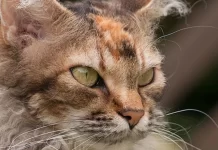The Bombay cat is ideal for anybody who has ever thought, “I’d like to have a panther, but maybe smaller and less bitey.”
The Bombay is a cross between the Burmese and the black American shorthair, and was created expressly to resemble the Indian black panther. The end result is a cat that, while having no wild blood in his ancestry, does resemble the large jungle cat.
The Bombay combines the toughness, devotion, and intellect of the Burmese without being nearly as loudly outspoken and while having a stunning, solid black coat, combining some of the greatest characteristics of both parent breeds.
Appearance
They do resemble little panthers from your living room. That specially bred coat is unquestionably what people notice about the Bombay the most. The coat is pure black, short, and very lustrous. The healthy, happy Bombay’s coat is sometimes compared by breeders to patent leather.
Visually, the Bombay is similar to the Burmese in build, but a touch less stocky and longer. They have a round head, short, round-tipped ears, and medium-sized, round, gold to copper-colored eyes. They are well-muscled cats.
The Bombay cat’s distinctive, swaying walking style adds to how much he resembles the black panther.
Temperament
The Burmese origins of the Bombay cat are quite evident in his demeanor. The Bombay is a very sociable, perceptive, and people-oriented cat. They develop close ties with the members of their families and really value human interaction. But it’s crucial to keep in mind that every cat is a unique creature with a distinct personality.
“Since Bombays were bred from Burmese and a black American domestic shorthair, they are apt to have a wide range of personalities [and] activity levels,” explains M. Leanne Lilly, DVM, DACVB, assistant professor-clinical at the Ohio State University Veterinary Medical Center. “The father’s genes are the main determinant of gregariousness, or being an outgoing, sociable cat. There is thus a great deal of individual variety. They are described as gregarious, friendly, courageous, playful, and wonderful family cats on most cat breed websites.
They are especially effective with kids because of their normally reserved but entertaining disposition. They thrive in houses with other cats as well, where they swiftly develop a pecking order and coexist peacefully.
The Bombay is a people-lover who follows their human partners a lot, watches everything they do, and tries to get involved in as many activities as they can. When they are kittens, they are very lively and powerful climbers and jumpers. The Bombay will become more relaxed as they get older and will enjoy some sofa time, but they will sometimes still love a game of fetch.
Bombay cats struggle to live on their own for long periods of time because of their intense social nature, according to Lilly. Of course, in homes with several cats, this is not a problem. But if the Bombay is left alone for more than a few hours at a period, stress problems may start to show up in families with only one cat.

Living Needs
Bombays are skilled climbers and jumps, therefore a climbing tower or scratching post with many levels is welcomed. Since they are naturally energetic cats, having a range of toys is a good idea, particularly those that enable you to play actively with them. This is because Bombay cats like playing and participating in activities with their human friends.
If you want to spend some (supervised) time outdoors or take them for a walk, your Bombay is probably going to enjoy the fresh air and time outside with you since they can be taught to walk on leashes.
Care
That short, streamlined coat almost looks after itself. While Bombays do lose some hair, it should be kept off your furniture and clothing with only a weekly brushing, especially during the regular shedding seasons when it is a bit thicker.
It wouldn’t be a bad idea for Bombays to wash their teeth a few times a week as well because gingivitis may be a problem for them. At the very least, provide some often consumed tartar-reducing snacks. Additionally, a dental exam could be required at some time.
Additionally, Bombays need regular nail trimming and a clean litter box just like any other cat breed.
Bombays are exceedingly energetic as kittens and are strong, nimble climbers and jumpers. The Bombay will become more relaxed as they get older and will enjoy some sofa time, but they will sometimes still love a game of fetch.
Health
Another benefit of their Burmese ancestry is in this regard. The Bombay breed has few significant genetic predispositions for health issues, making it a very healthy breed.
Having said that, sinus problems may be a bothersome condition, therefore it is advised to keep a check on your child’s teeth and gums.
Being Burmese-derived and having typically rounder features, they may be more susceptible to nasal disorders including sinus problems and asthma, which may also be linked to allergies or just poor drainage in a less-elongated face, according to Lilly. If their dental alignment is slightly squeezed, they may also be susceptible to gingivitis or other dental diseases.
The breed may also get a little chonky if food consumption isn’t controlled, particularly as they age. Many veterinarians advise meal-style feeding as opposed to leaving a bowl of food out and letting cats eat at their leisure to help counteract this.
According to Michelle Beck, DVM, CCRT, CVA, of the Backlund Animal Clinic in Omaha, Nebraska, “overall, I tend to recommend meal feedings—generally twice a day—and having that food down for 15-20 minutes, then picking it back up again so the cat knows that’s their window.” “If you’re doing meal feedings, then those are times you can specifically separate out those animals, so they each get a set amount of food for a set amount of time,” says the owner of a multi-pet home.
Additionally, Beck advises owners to be cautious when it comes to the diets of cats that have had spaying or neutering.
The amounts recommended on the labels of the food bags that we buy are for feeding animals that are still whole, according to Beck. “But because the majority of cats nowadays are spayed or neutered, a cat’s body no longer has those hormone systems, which affects how they metabolize food. On average, calories must be decreased by 30% from what is shown on the bag.
Bombay cats typically live for 15 years, but due to their hardiness, it’s not unusual for well-cared-for cats to live for 20 years.

History
Nikki Horner, a breeder from Louisville, Kentucky, came up with the idea for the Bombay because she wanted to make a dog that looked like the Indian black leopard. She bred Burmese cats with black American shorthairs to obtain her appearance. Her ideal cat would have the shorthair’s jet-black coat and the Burmese’s robust, muscular frame. To complete the appearance, she deliberately sought shorthairs with golden eye colors. In 1965, she was successful in giving birth to a whole litter of black-haired, golden-eyed kittens that would later serve as the ancestors of the Bombay breed.
To remind people of the black panthers the cat is intended to resemble, the breed was given the name Bombay after the Indian city. The Bombay is a genetically separate breed that was recognized by the Cat Fanciers Association (CFA) in 1970 and The International Cat Association (TICA) in 1979. Burmese and American shorthairs are currently acceptable outcrossing mates for the breed.


















